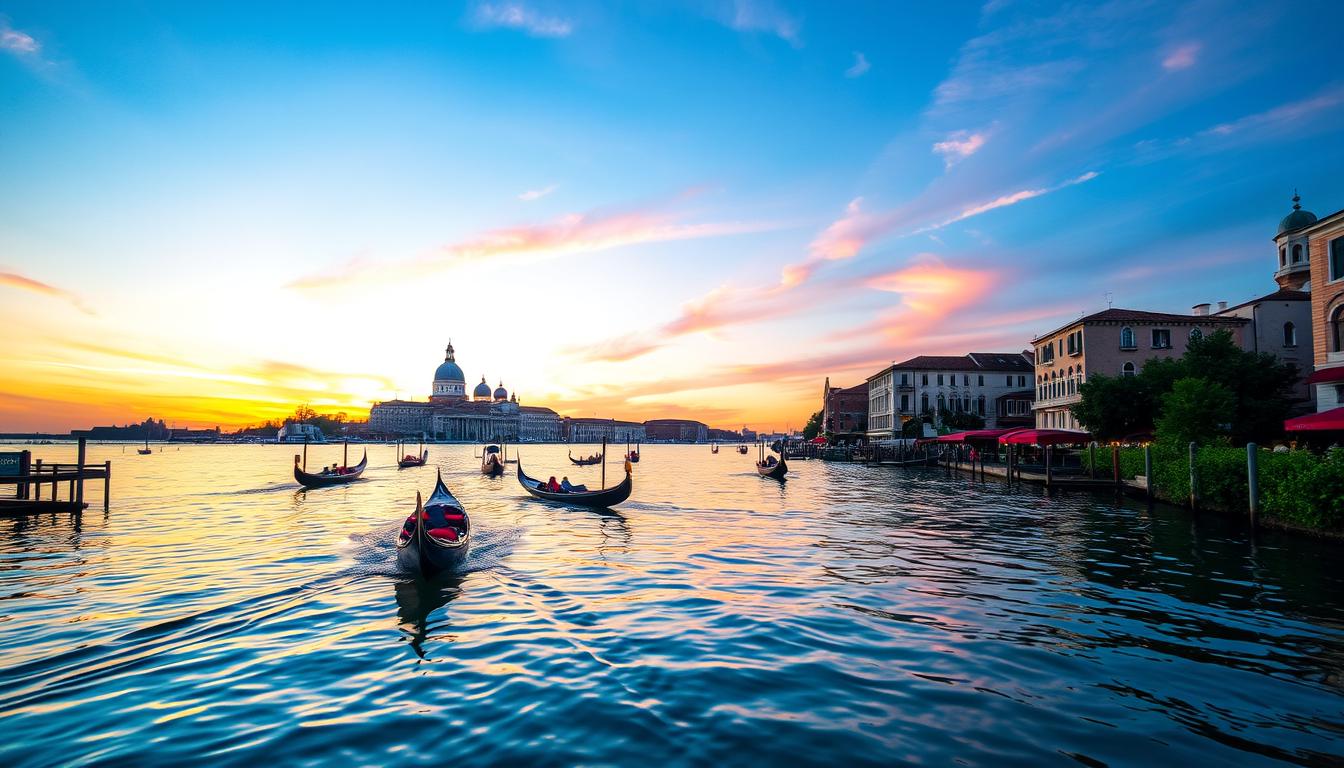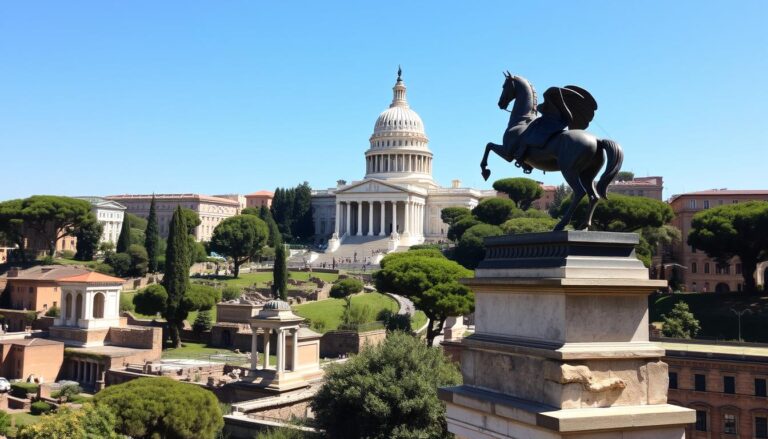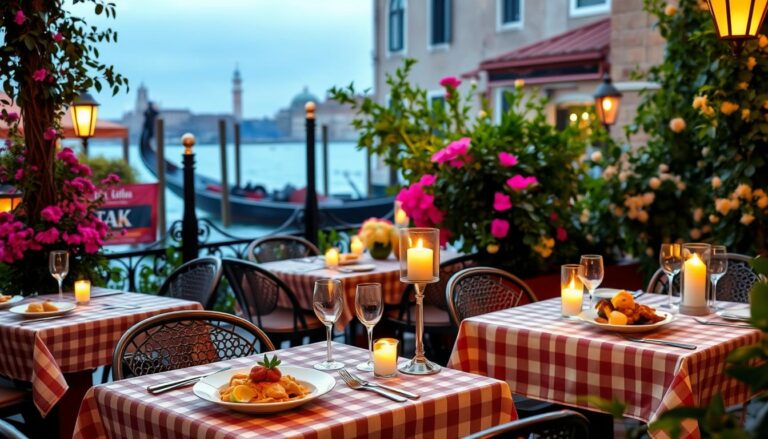Venetian Lagoon: Timeless Beauty of Islands & History
Imagine yourself gliding through a liquid maze where history whispers in every wave. The Venetian lagoon is more than a landscape; it’s a living masterpiece that has drawn travelers for centuries. Venice, Italy, is a symbol of human strength, with 118 islands connected by water and sky.
Your trip to this UNESCO World Heritage Site will be unforgettable. As you move across the sparkling waters, you’ll see why the Venetian lagoon is unique. Each island has its own tale, from Murano’s glassmaking to Burano’s colorful buildings.
Picture a place where time freezes yet is filled with history. The Venice lagoon is not just a place; it’s an experience that connects you to beauty and history.
Table of Contents
Introduction to the Venetian Lagoon
The Venetian Lagoon is a key part of Italy’s rich history. It combines centuries of culture and sea trade. Located in northeastern Italy, this water area has greatly influenced Venice, one of the world’s most special cities.
Venice started after the Roman Empire fell, with its first settlements in AD 568. Its location helped it grow strong during the Lombard invasions. It turned a group of wetlands into a major sea power.
Foundations of a Legendary City
Venice’s history is filled with important moments:
- First elected doge, Orso, chosen in 727
- Rialto islands became a city in the 10th century
- It became a global financial hub by the 9th century
Cultural Significance in Italian Heritage
“Venice is not just a city, but a living museum of human civilization.” – Anonymous Historian
The lagoon is more than a place—it shows Italy’s strength and creativity. It has 472 bridges and 127 islands. Venice’s story is one of human ingenuity and adaptability.
| Historical Milestone | Year |
|---|---|
| Traditional Founding Date | 421 AD |
| UNESCO World Heritage Site Inscription | 1987 |
| Period as Republic Capital | 810-1797 |
The Venetian Lagoon is more than a place to visit. It’s a deep story of human success, cultural sharing, and amazing buildings.
Unique Ecosystem of the Lagoon
The Venetian Lagoon is a special place, covering about 10 km by 50 km. It’s a mix of saltwater and freshwater. This area is home to a wide variety of life, making it a key wetland in the Mediterranean.
Flora and Fauna Highlights
Exploring the lagoon shows a rich marine life. It has many species that live well in its unique conditions:
- Salt marshes host rare birds like pink flamingos and avocets
- There are special plants like glasswort and spartina marittima
- It’s full of tiny life forms like phytoplankton and bacterioplankton
“The Venetian Lagoon is a living museum of ecological complexity.” – Environmental Research Institute
Conservation Efforts
Local groups are working hard to save this important place. They face big challenges like rising sea levels and less sediment.
| Conservation Strategy | Impact |
|---|---|
| MOSE Flood Barrier | Operational since 2020, protects against sea-level rise |
| Tourist Regulation | Limited group sizes to 25 people, entry fee of 5 euros |
| Salt Marsh Preservation | Absorbs 30 times more carbon than typical forests |
By learning about and protecting this lagoon, you help save a truly amazing place.
Iconic Islands to Explore
The Venetian Lagoon is filled with unique islands, each with its own story. Venice has 118 islands, but three are must-sees for real experiences in Italy.
Visiting these islands lets you see Venice’s rich culture. You’ll learn about its art and history.
Murano: The Glassmaking Capital
Murano is known for its amazing glasswork in Italy. It started in the 7th century and has 7 islands. For over 700 years, glassmakers here have made incredible pieces.
- See glassblowing live
- Check out artisan workshops
- See the Romanesque church of San Donato with its huge mosaic floor
Burano: A Photographer’s Dream
Burano is 11 kilometers from Venice and is full of colorful houses. It’s been around since the 6th century and is famous for lace-making.
- Take amazing photos of the houses
- Learn about lace-making
- Visit local workshops
Torcello: Whispers of Ancient History
Torcello is the oldest place in the Venetian Lagoon. It was once home to 20,000 people but now is peaceful.
- See the 7th-century Cathedral of Santa Maria Assunta
- Admire Byzantine mosaics
- Check out the Devil’s Bridge
You can get to these islands by Vaporetto (water bus) from Fondamente Nove. Routes 4.1, 4.2, 12, 13 go to Murano. Route 9 goes to Torcello.
“Each island in the Venetian Lagoon tells a unique story of craftsmanship, tradition, and beauty.” – Venice Travel Guide
Navigating the Venetian Lagoon
Exploring the Venetian Lagoon needs careful planning and knowing your transport options. Your trip through this special water world can be thrilling and green. It offers many ways to see the area’s rich sea history.
Best Modes of Transportation
There are several ways to get around the Venetian Lagoon, each suited to different tastes and wallets:
- Public Vaporetti (Water Buses)
- Private Water Taxis
- Guided Boat Tours
- Kayak Expeditions
For those who care about the planet, public vaporetti are a great choice. These water buses link islands, helping you see the lagoon while being kind to the environment.
Suggested Itineraries
Here are some top routes to make the most of your Venetian Lagoon adventure:
| Duration | Islands Visited | Recommended Experience |
|---|---|---|
| Half-Day Trip | Murano, Burano | Glass-making and Colorful Houses |
| Full-Day Expedition | Murano, Burano, Torcello | Cultural and Historical Exploration |
| Multi-Day Adventure | All Major Islands | Comprehensive Lagoon Experience |
Pro tip: Think about CroisiEurope’s 6-day, 5-night cruises for a deep dive into the lagoon. These all-inclusive trips let you fully experience Venice’s beautiful waterways.
“The Venetian Lagoon is not just a destination, it’s a living, breathing ecosystem waiting to be discovered.” – Local Venetian Guide
The Vibrant Local Cuisine
Venice offers a culinary journey that reflects its unique maritime heritage. The city’s cuisine is a delightful exploration of flavors deeply rooted in the traditions of italy and the specific environment of venice’s lagoon.
The local food scene is a testament to the region’s rich gastronomic history. Seafood plays a pivotal role in Venetian cooking, with fresh catches from the Adriatic Sea forming the backbone of most traditional dishes.
Traditional Venetian Dishes to Savor
- Cicchetti: Venetian tapas that offer a delightful sampling of local flavors
- Risotto al Nero di Seppia: A dramatic squid ink risotto showcasing the lagoon’s seafood
- Sarde in Saor: Sweet and sour sardines that blend unique flavor profiles
- Baccalà Mantecato: Creamy dried cod spread highlighting historical trade influences
- Bigoli in Salsa: Thick pasta with a traditional sauce that captures venetian cuisine
Culinary Experiences in Venice
Your culinary adventure should include exploring the famous Rialto Market, where fresh seafood tells the story of venice’s relationship with the sea. Local bacari (wine bars) offer an authentic experience of sampling cicchetti while enjoying local wines.
“In Venice, every meal is a celebration of local ingredients and centuries-old culinary traditions.”
Recommended Dining Spots
- Antiche Carampane – For authentic seafood experience
- Osteria Al Squero – Perfect for local cicchetti
- Venissa Restaurant – Showcasing innovative local cuisine
The culinary landscape of venice is a delicious journey through history, geography, and culture. From seasonal specialties like Moleche fritte (soft-shell crabs) to traditional Risi e Bisi (pea risotto), each dish tells a story of this remarkable italian destination.
Cultural Experiences in the Lagoon
The Venetian Lagoon is a treasure trove of cultural experiences. It showcases Italy’s rich history. Here, art, music, and tradition blend beautifully.
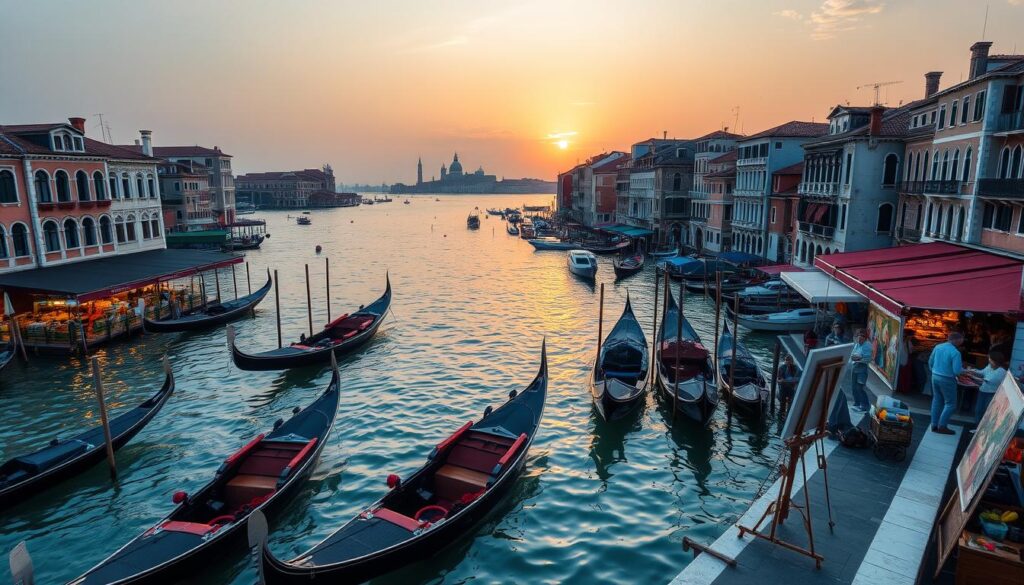
Festivals and Events
Venice’s festivals are a big deal, attracting people from all over. The Carnival is a highlight, drawing over 150,000 visitors. The Regata Storica is another must-see, held in September. It features rowing in historical costumes.
- Carnival attracts international visitors in February
- Regata Storica showcases traditional Venetian maritime culture
- Festivals highlight Venice’s rich cultural heritage
Art and Music Scene
The 60th Venice Biennale of Art is a major event in the art world. You can enjoy various artistic experiences through workshops and tours:
- Murano Glass Craftsmanship Workshops (4.92/5 rating)
- Tintoretto Workshop for hands-on printing experiences
- Design a Venetian Silkscreen Workshop
“Venice is not just a city, but a living canvas of artistic expression.” – Venice Cultural Foundation
Small group tours, with only 20 people, offer a close look at Venice’s art scene. Whether you’re into glass-making, historical tours, or music, Venice has something special for you.
The Magical Sunset Views
The Venetian Lagoon turns into a stunning canvas as the sun sets. It paints the sky with amazing colors that attract photographers and travelers. Venice is known for its breathtaking sunsets, where light plays on historic waterways and buildings.
Best Viewing Spots
Choosing the right spot can make your sunset experience in the Venetian Lagoon even better. Here are some top places to see magical moments:
- Ponte dell’Accademia: Offers sweeping views of the Grand Canal
- San Giorgio Maggiore Bell Tower: Provides 360-degree panoramic views
- Zattere Promenade: A serene waterfront with unobstructed sunset perspectives
- Giudecca Island: Less crowded with stunning lagoon reflections
- Fondaco dei Tedeschi Rooftop: Panoramic vista with free entry (reservation required)
Photography Tips
To capture Venice’s beauty, you need to plan and use the right techniques. Professional photographers suggest:
- Arrive 30 minutes before sunset to secure the best position
- Use a tripod for stable, crisp images
- Set camera to golden hour settings: lower ISO, wider aperture
- Experiment with water reflections for dramatic compositions
“Sunset in Venice is not just a moment, it’s a painting that nature creates exclusively for you.” – Anonymous Traveler
Seasonal Sunset Insights
| Season | Sunset Time | Recommended Viewing Location |
|---|---|---|
| Winter | 4:30 PM – 5:00 PM | Rialto Bridge |
| Spring | 7:00 PM – 8:00 PM | Accademia Bridge |
| Summer | 8:30 PM – 9:15 PM | Venice Lido |
| Autumn | 6:00 PM – 7:00 PM | Cannaregio District |
Every sunset in the Venetian Lagoon is a unique sight. It turns Venice into a living masterpiece that touches the hearts of all who see it.
Exploring the Lagoon by Boat
Boat tours in the Venetian lagoon are unforgettable. They connect you with the area’s rich maritime history. The lagoon, covering about 550 square kilometers, has many water-based activities for all.
Exploring the lagoon’s waters lets you see sustainable tourism efforts. You’ll also enjoy stunning views of Venice.
Types of Boat Tours Available
The Venetian lagoon has many boat tour options:
- Traditional gondola rides through narrow canals
- Motorboat excursions to surrounding islands
- Sunset cruises with photography opportunities
- Multi-day cruise experiences
- Eco-friendly sailing tours
Private vs. Group Tours
Choosing between private and group tours depends on your style and budget. Here’s a comparison to help you decide:
| Tour Type | Pros | Cons |
|---|---|---|
| Private Tours | Personalized experience, flexible schedule | Higher cost, less social interaction |
| Group Tours | More affordable, social atmosphere | Fixed schedule, less customization |
When exploring the Venetian lagoon, think about eco-friendly tours. These tours support sustainable tourism and have a low environmental impact.
“The beauty of the Venetian lagoon is best experienced from the water, where history and nature converge.” – Local Venetian Guide
The lagoon has around 118 islands, with only 20 inhabited. This offers many chances for unique maritime adventures.
Preserving the Venetian Lagoon
The Venetian Lagoon is facing big environmental challenges that need quick action and new ways to protect it. Venice’s special ecosystem is at risk from many environmental threats. These could change its landscape and cultural heritage a lot.
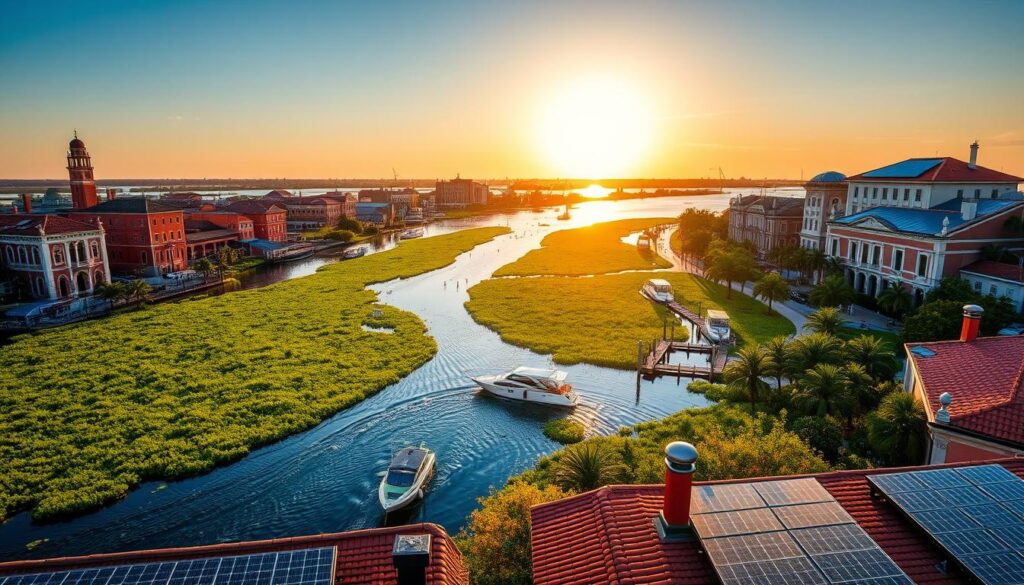
Venice is dealing with serious environmental issues that need a full protection plan. The city is sinking at a rate of 2 to 4 centimeters each century. Sea levels are expected to go up by 28 to 101 centimeters by 2100. This shows how important it is to have sustainable tourism and protect the environment.
Environmental Challenges
The main environmental problems the Venetian Lagoon faces include:
- Continuous land subsidence
- Rising sea levels
- Increased flooding risks
- Ecosystem degradation
- Tourism-related environmental stress
“Preserving Venice is not just about saving a city, but protecting a global cultural treasure.” – Environmental Conservation Expert
Local Community Initiatives
Local communities have come up with creative ways to protect the environment. The MOSE project is a big step in Venice’s conservation efforts. It has 78 mobile barriers to fight flooding, showing the city’s commitment to managing its environment sustainably.
You can help these efforts by:
- Practicing sustainable tourism
- Respecting local environmental guidelines
- Supporting local ecological preservation projects
- Minimizing your environmental footprint
Every visitor can help protect this amazing ecosystem for the future.
Tips for First-Time Visitors
Exploring Venice is magical but needs some planning. You’ll navigate canals and historic streets. Knowing a few tips can make your trip better.
Essential Items to Pack
Packing for Venice is all about smart choices. You’ll need special gear for the city’s unique environment. This ensures a comfortable trip.
- Comfortable walking shoes for cobblestone streets
- Waterproof jacket (essential during potential “acqua alta” flooding)
- Lightweight, versatile clothing
- Portable battery charger
- Reusable water bottle
- Small daypack for exploring
Understanding Local Etiquette
Respecting Venice’s customs makes your trip better. The city’s rich culture asks for mindful behavior from visitors.
| Custom | Recommendation |
|---|---|
| Dress Code | Modest clothing when visiting religious sites |
| Tipping | 10% in restaurants, not mandatory |
| Language | Learn basic Italian phrases |
“When in Venice, do as the Venetians do – observe, respect, and immerse yourself in the local culture.”
Remember, Venice is more than a place—it’s an experience. Plan well, respect the locals, and you’ll make unforgettable memories in this amazing Italian city.
Conclusion: Embrace the Lagoon’s Charm
Your trip through the Venetian Lagoon is more than just a vacation. It’s a mix of natural beauty, rich culture, and traditions that make every moment special. From Burano’s colorful streets to Venice’s historic canals, each island shows a different side of history and modern life.
The Venetian Lagoon is not just a place to visit; it’s an experience that connects you with centuries of history. You can learn about glassmaking in Murano, see the bright houses of Burano, or explore Torcello’s ancient roots. Every visit helps keep these special places alive and supports the local people who care for them.
When you plan your trip, remember to travel responsibly. Respect local ways, support traditional crafts, and enjoy each experience with wonder. The beauty of this place is not just in its sights but in the deep connections it has with its people and history.
Get ready to be changed by the Venetian Lagoon. It’s a place where every canal has a story, every island has a secret, and every moment is a chance to connect with something amazing. Your adventure in Italy is waiting.

